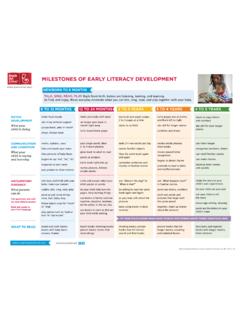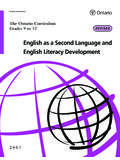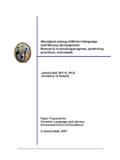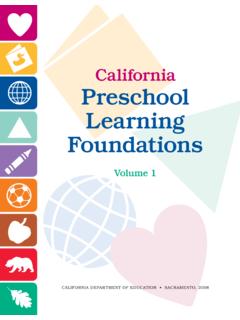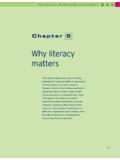Transcription of Defining, measuring and improving health literacy - WHO
1 defining , measuring and improving health literacy Don Nutbeam, Professor of Public health University of Southampton, UK. health literacy has become a popular issue in the past decade: Rise in publications on health literacy 2000-2013. Chart from Thomson-Reuters Web of Science database. Accessed February 2015. health literacy is not new health literacy goals for Australia in 1993. 3. Australia's health literacy goals 1993. health literacy was one of four major groups of goals and targets, and defined as the ability to gain access to, understand and use information in ways that promote and maintain good health . To achieve the goals of the Australian Language and literacy Policy To enhance knowledge and improve health literacy to enable people to make informed choices about their health To enhance knowledge and improve health literacy to enable people to take an active role in bringing about changes in the environments that shape their health Nutbeam D, Wise M, Bauman A et al in Goals and Targets for Australia's health , Canberra, AGPS 1993 4.
2 health literacy and health promotion health Promotion health Promotion Intermediate Social and health Actions Outcomes health Outcomes Outcomes (intervention impact (modifiable measures) determinants of health ). Education health literacy Healthy behaviours and Examples include: Measures include: practices: health and patient health -related knowledge, Measures include: tobacco education, attitudes, behavioural and alcohol use, food Social Outcomes broadcast media intentions, personal skills, choices, hygiene practices, Measures include: communication self-efficacy use of medicines quality of life, functional independence, Social mobilisation Social action & influence Effective health service social capital, Examples include: Measures include: Measures include: equity community community participation, provision of preventive development, social support, social norms, services, access to and mobilisation public opinion appropriate health services health Outcomes Advocacy Healthy public policy & Healthy Environments Measures include: Examples include: organisational practice Measures include: reduced morbidity, Lobbying, political Measures include.
3 Safe physical environment, disability, organisation and policy statements, supportive economic and avoidable mortality activism, legislation, regulation, social conditions, food and overcoming resource allocation water security. bureaucratic inertia organisational practices Nutbeam D. Evaluating health Promotion: Progress, Problems and Solutions. health Promotion International, 1998. 13(1): 27-44. health literacy and health promotion health Promotion health Promotion Intermediate Social and health Actions Outcomes health Outcomes Outcomes (intervention impact (modifiable measures) determinants of health ). Education health literacy Healthy behaviours and Examples include: Measures include: practices: health and patient health -related knowledge, Measures include: tobacco education, attitudes, behavioural and alcohol use, food Social Outcomes broadcast media intentions, personal skills, choices, hygiene practices, Measures include: communication self-efficacy use of medicines quality of life, functional independence, Social mobilisation Social action & influence Effective health service social capital, Examples include: Measures include: Measures include: equity community community participation, provision of preventive development, social support, social norms, services, access to and mobilisation public opinion appropriate health services health Outcomes Advocacy Healthy public policy & Healthy Environments Measures include: Examples include: organisational practice Measures include: reduced morbidity, Lobbying, political Measures include.
4 Safe physical environment, disability, organisation and policy statements, supportive economic and avoidable mortality activism, legislation, regulation, social conditions, food and overcoming resource allocation water security. bureaucratic inertia organisational practices Nutbeam D. Evaluating health Promotion: Progress, Problems and Solutions. health Promotion International, 1998. 13(1): 27-44. health literacy and health promotion health Promotion health Promotion Intermediate Social and health Actions Outcomes health Outcomes Outcomes (intervention impact (modifiable measures) determinants of health ). Education health literacy Healthy behaviours and Examples include: Measures include: practices: health and patient health -related knowledge, Measures include: tobacco education, attitudes, behavioural and alcohol use, food Social Outcomes broadcast media intentions, personal skills, choices, hygiene practices, Measures include: communication self-efficacy use of medicines quality of life, functional independence, Social mobilisation Social action & influence Effective health service social capital, Examples include: Measures include: Measures include: equity community community participation, provision of preventive development, social support, social services, access to and mobilisation norms, public opinion appropriate health services health Outcomes Advocacy Healthy public policy & Healthy Environments Measures include: Examples include: organisational practice Measures include: reduced morbidity, Lobbying, political Measures include.
5 Safe physical environment, disability, organisation and policy statements, supportive economic and avoidable mortality activism, legislation, regulation, social conditions, food and overcoming resource allocation water security. bureaucratic inertia organisational practices Nutbeam D. The Evolving Concept of health literacy . Social Science and Medicine. 2009. , 2072-78. literacy and health Relationship between low literacy and a range of health related outcomes well established Some indirect effects related to employment and lifetime income Some direct effects of low literacy , individuals are*. Less responsive to health education, less likely to use disease prevention services, and Less likely to successfully manage chronic disease *Berkman N D, Sheridan SL, Donahue KE, Halpern DJ, Crotty. 2011. Low health literacy and health Outcomes: An Updated Systematic Review. Annals of Internal Medicine, 155, 97-107. 8. literacy is context and content specific More accurate to talk about literacies for example: Financial literacy , Science literacy Media literacy , IT literacy (new literacy ) and, health literacy 9.
6 What is health literacy ? health literacy is the possession of literacy skills that are required to make health related decisions in a variety of different environments health literacy describes the cognitive and social skills which determine the motivation and ability of individuals to gain access to, understand and use information in ways which promote and maintain health *. health literacy represents an observable set of cognitive and social skills that will vary from individual to individual. These skills enable individuals to obtain, understand and use information to make decisions and take actions that will have an impact on their health status. *Nutbeam D. health Promotion Glossary (1999) health Promotion International, 13(4): 349-364. 1999 (also - WHO/HPR/ ). 10. health literacy is also context and content specific for example influenced by age, and stage in life a pregnant woman attending an older person with ante-natal classes chronic joint disease a young person receiving health education on illicit drugs at school.
7 11. health literacy is context and content specific for example influenced by disease type and socio- economic conditions A person with diabetes receiving community education to patient education reduce the spread of Ebola a mother receiving education on oral rehydration to treat diarrhoea 12. measuring health literacy in absolute and relative terms In absolute terms we distinguish between those who have basic skills that enable them to access, understand, and use information for health , and those who do not. In relative terms we assess the skill differences between those who are able to apply more advanced cognitive and literacy skills to perform relatively challenging tasks in understanding and applying information for health , and those who cannot. 13. measuring relative differences in health literacy Several simple measures of health literacy have been tested, refined and validated over the past 20 years for use as screening tools in clinical practice, These are generally insufficient to measure relative differences in health literacy and work is underway to develop more complex measures for health literacy in several countries These measures include assessment of a person's ability to gain access to age and context specific information from a variety of different sources.
8 Discriminate between sources of information understand and personalise health information that has been obtained appropriately apply relevant health information for personal benefit 14. Distinctions between absolute and relative health literacy has led to two conceptualizations of health literacy Absolute measures of health literacy have had greatest application in clinical care. health literacy is conceptualized as a risk to be assessed and managed through adapted communication and environmental modification Relative measures of health literacy have had greatest application in public health . health literacy is conceptualized as an asset to be developed, as an outcome to health education and communication *Nutbeam D. 2008. The evolving concept of health literacy . Social Science and Medicine. 67. 2072-78. 15. Relative differences in health literacy *. Functional health literacy Basic health literacy skills that are sufficient for individuals to obtain relevant health information and apply that knowledge to a limited range of prescribed activities.
9 Interactive health literacy More advanced literacy skills that enable individuals to extract information and derive meaning from different forms of communication; to apply new information to changing circumstances; and to interact with greater confidence with information providers such as health care professionals. Critical health literacy Most advanced cognitive skills which, together with social skills, can be applied to critically analyse information, and to use this information to exert greater control over life events and situations. *Nutbeam D. (2001) health literacy as a Public health Goal: A challenge for contemporary health education and communication strategies into the 21st Century. health Promotion International, 15; 259-67. 16. Relative differences in health literacy Classification of functional, interactive and critical health literacy indicates: Different categories of health literacy progressively allow for greater autonomy in decision-making, and personal empowerment.
10 Progression between categories is not only dependent upon cognitive development, but also exposure to different forms of information (content and media). It is also dependent upon a person's confidence to respond to health communications described as self-efficacy. 17. improving functional health literacy health literacy can be improved through education and is a measurable outcome to health education Differences in educational methods, media and content will result in different learning outcomes improving functional health literacy based on relatively limited communication of factual information on health risks, and on how to use medications and health care services 18. improving interactive and critical health literacy Interactive health literacy improving interactive health literacy will require the use of more interactive forms of health education directed towards improving self- confidence to act on information and advice received. This is best delivered in a more structured educational setting, or through well designed on-line learning programmes.










